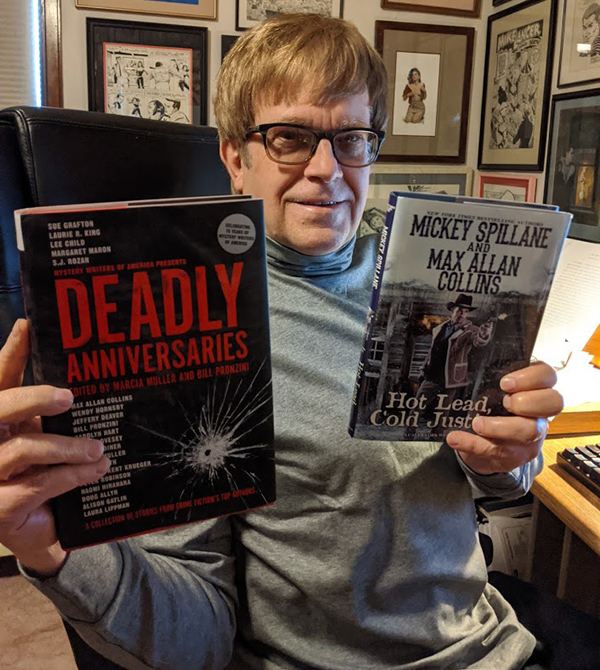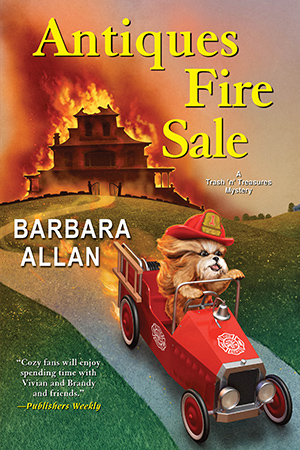I’m going to discuss audio today, specifically (but not exclusively) music.
I have been blessed with having some incredible narrators read the audio versions of my novels, with “the voice of Nate Heller,” Dan John Miller, out right now with Do No Harm. Also current is Masquerade for Murder read by Stefan Rudnicki, whose Quarry readings have been favorites of mine and many of you. Jack Garrett, who did a fine job on Last Stage to Hell Junction, has Hot Lead, Cold Justice coming this month.
Our habit is to listen to the audio books of our stuff in the car. So we have yet to adjust to listening at home. Since we are liable to be sheltering in place (in some form or another) until a vaccine arrives, that will probably change.
I depend on habit – on routine – to keep me sane in what I cheerfully think of as the random terror of the chaos that is life. Just this weekend, I finished writing the new Caleb York, Shoot-out at Sugar Creek, although I have not done the final read-through in search of typos, inconsistencies and the need for occasional tweaks. That’s a process that takes a couple of days. Barb enters the corrections and changes for me. More habit. More routine.
When I finish my draft (final but for what I mentioned above), I clean my work space. I begin projects with a pristine office and by the end of a project, my office has had a nervous breakdown. Perhaps it’s the historical nature of so much of what I write, but books and other research materials, and discarded drafts of pages and even chapters, are flung and scattered on a floor increasingly difficult to traverse.
When I clean the office, which takes a day or so, I listen to music. Right now, that’s about the only time I do listen to music, despite a CD collection as voluminous as my DVD/Blu-Ray library. As with audio books, music has been relegated to listening in the car. Which means it, like audio books, is hampered by not much driving happening.
And another habit, another part of our routine, is to take a day or two or even three off at the end of a project and do a getaway. No, not to some exotic vacation spot – just to Galena, Des Moines or suburban Chicago (trips to St. Louis were part of that, for the years when Nate and Abby and son Sam, and later daughter Lucy, were living there). Nothing elaborate – just dining and shopping and maybe a movie. Another habit is to take a day off during the writing process – working six days a week – to either Iowa City/Cedar Rapids or Davenport. More audio in the car gets listened to on those days.
Days not happening right now.
So the audios of our books are piling up. A year from now or so, if a vaccine or other credible treatment has emerged, and we can emerge too, we’ll have plenty to listen in the car. Including the new Weezer CD I just ordered.
And yet music has been an important part of how I’ve settled into the new routine here in Corona-ville. (This score just in – Corona 19, Trump zero).
You may recall – if you’re bored enough or perhaps masochistic enough to follow these update/blogs regularly – that I have resumed my ‘90s and early ‘00s obsession with collecting laserdiscs. I had dumped many of my discs, cheap, since I’d upgraded to DVD and Blu-ray on most of them, and hung onto only the things not available in those later formats.
But laserdiscs look terrible on flat screen TVs, so I invested in a 19″ CRT and bought a used laserdisc player from e-bay and set it up in my office. And, much to my wife’s dismay, I started buying laserdiscs again (through e-bay). Sometimes these are movie titles otherwise unavailable; but mostly they are music – a lot of stuff from the ‘80s and early ‘90s isn’t available elsewhere, as well as things from the ‘50s and ‘60s that got laserdisc-only releases (usually collections, like Rock ‘n’ Roll: The Greatest Years).
I won’t bore you with details, but Japan put out of lot of laserdiscs with clips from the UK’s Beat Club and the USA’s Shindig and other sources that were rarely available here, except on the gray market. These laserdiscs look and sound particularly good. And I eventually had to replace my player with a cool silver one made in Japan, which is superior to our models.
The Japanese in particular put out collections of British invasion material, including discs dedicated to single groups, sometimes with interview and documentary footage. Wonderful discs include some of my favorite bands, like the Animals, the Yardbirds, and the Dave Clark Five. Artists of the mid-‘60s through the early ‘70s are represented in collections with incredible performances, like the Vanilla Fudge doing “Keep Me Hangin’ On” and “Shotgun,” and Dusty Springfield doing…well, anything.
Now what I’m about to say is no revelation, not even to me. But at my age, listening to this music, and seeing the artists performing it, hits me emotionally harder than I expected. I got these discs because I liked the music and the artists. But seeing those artists, back in the day, performing that music, swept me back; memories and feelings surged and swelled.
People talk about music – particularly the pop music you grow up with – being the soundtrack of your life. That’s a cliche, I know, but like all cliches, it has more than a kernel of truth. Nothing takes me back to the ‘70s more fully than seeing Karen Carpenter singing Paul Williams tunes, although Three Dog Night doing Paul Williams comes close.
Barb and I encountered Karen and Richard Carpenter (we didn’t exactly meet them, just exchanged a few pleasantries) in the green room at Good Morning America when I was promoting Dick Tracy in the early ‘80s. Karen was skeletal, probably a few months away from dying, and Barb and I were shocked by the alarming sight of her. Apparently she had low self-esteem (also an observation that is less than revelatory) but it’s so damn tragic to think of that incredible, rich voice living inside that frail, damaged body and soul.
I wasn’t particularly a huge Carpenters fan. I remember liking “Merry Christmas, Darling,” and I was not an imbecile, so I knew a lovely voice when I heard it. But like a lot of us at the time, I dismissed the Carpenters as corny and the production as too slick and a sign that the rougher-edged ‘60s were over. It was Paul Williams and Phantom of the Paradise (still among my favorite movies) that began my reassessment, largely thanks to Jessica Harper’s rich, Karen Carpenter-like singing, and seeing Richard Carpenter’s sister in the disturbing flesh – a victim of her own self-doubt – added a tragic patina.
Likewise seeing Eric Burden or Rick Nelson or Bobby Vee (I already had every scrap of Darin, so little of him has turned up on laserdisc, though a few great “Mack the Knife” renditions are collected here and there) stirred memories specific and general. For me, the funny thing is I’ve always been into nostalgia – but mostly second-hand nostalgia, for the ‘30s and ‘40s of my parents, thanks in part to Warner Bros cartoons and the Three Stooges, and for the ‘50s which I remembered only vaguely from early childhood – my first record was a 78 of Elvis (“Hound Dog”/”Don’t Be Cruel”).
But I never really understood – never experienced – nostalgia in a meaningful, personal way until I saw these laserdiscs. I now realize that the best years of my life are indeed over, even as lucky as I am and as happy as I am to still be on this planet, despite a pandemic and a political scene that dismays and discourages daily.
Like Karen Carpenter, Carly Simon is an artist I had taken for granted. Carole King I always valued, as did Barb; but somehow when I thought of Carly Simon, what came to mind was her first album’s jacket with that fetching bra-less photo of her. But what I, in my continuing male wretchedness, failed to appreciate at the time was how many great songs, performed in a warmly personal and open style, this woman gave us. A live laserdisc reminded me – Simon has an incredibly winning awkward grace in performance – and a three-CD boxed set of hers is what I listened to cleaning my office.
Watching Cyndi Lauper on laserdisc, performing wildly and well and with complete abandon to an audience in Paris, reminds me how much I enjoyed the early ‘80s…how fantastic those years were, when both Nate Heller and Nate Collins came into the world, when Barb and I were loving New Wave music and in so many ways coming into our own. And how, now, astonishingly, the ‘80s are suddenly a long time ago. I mean, I already knew the ‘60s and even the ‘70s were a long time ago.
But the ‘80s?
And weren’t the ‘90s last week?
The mingled joy and sadness of revisiting this music – hearing it, seeing it – has helped me adjust to sheltering in place. Hey, I know we’re lucky. I can still work – in fact, I have now hit my stride and thrown off any initial sluggishness and am working pretty much every day. But with a laundry list of underlying health issues, at a ripe old age, I am not going anywhere for a while, except the pharmacy and supermarket.
Even Warren Zevon, faced with cancer’s death sentence, got to see the latest James Bond movie before he passed. And maybe that says it all – that my biggest worry right now is not being able to see the new James Bond movie in a theater.
Music is calming and reassuring and the only method of time travel science has yet come up with. Back in the ‘80s, when I was having a lot of stress on Dick Tracy due to editorial interference, I found the only things that soothed me were Johnny Mathis and Sade records…they were mellow, and mellowed me out. You go to the shrink; I’ll listen to “Chances Are” and “Smooth Operator.”
And when I hear Eric Burden or the Vanilla Fudge or Rick Nelson or so many other artists, I feel the urge to play music again…even though I haven’t touched my organ (get your mind out of the gutter) since the pandemic began. But it does seem that, whenever I tell myself I have hung it up where rock and roll is concerned, something comes on the radio that gets the juices flowing again.
Yesterday I cancelled my band’s July 4 gig. We have only one date this year that I haven’t cancelled – it’s in September. We’ll see.
Never say die.
Also, never say never again.
* * *
Thanks to those of you who participated in the Antiques Fire Sale book giveaway. The books were sent out last week.
Check out this great review of Girl Can’t Help It from Bookgasm.
This is part two of a really nice article/interview about/with me, with an emphasis on Mike Hammer and Masquerade for Murder.
Here’s an essay I wrote about the process of writing the Mike Hammer novels – ground I covered here a while back, but a somewhat different take.
I was asked to write about my five fictional private eyes. Check it out here.
This is a look at my graphic novel (with Kia Asamiya), Batman – Child of Dreams, with a ton of scans.
Finally, here’s a link to the interview Barb and I wrote for Brandy and Vivian Borne to boost Antiques Fire Sale.
M.A.C.












